
An introduction to Shinto, one of Japan's earliest belief systems. Created by Asian Art Museum.
- Subject:
- Arts and Humanities
- Religious Studies
- Material Type:
- Lesson
- Provider:
- Khan Academy
- Provider Set:
- Khan Academy
- Date Added:
- 03/15/2021

An introduction to Shinto, one of Japan's earliest belief systems. Created by Asian Art Museum.

This course is a client-based land analysis and site planning project. The primary focus of the course changes from year to year. This year the focus is on Japan's New Towns.
Students will review land inventory, analysis, and planning of sites and the infrastructure systems that serve them. They will also examine spatial organization of uses, parcelization, design of roadways, grading, utility systems, stormwater runoff, parking, traffic and off-site impacts, as well as landscaping. Lectures will cover analytical techniques and examples of good site-planning practice. Requirements include a series of assignments and a client-based project.

Written as a teacher's guide for Misaki's Journal, the Teacher's Notebook contains vocabulary lists for each journal entry, activities that further learning and interaction with Japanese culture, and more.
Please also check out the Authentic-Like Interactive Materials for all materials mentioned in the Teacher's Notebook.
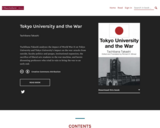
Tachibana Takashi analyzes the impact of World War II on Tokyo University and Tokyo University’s impact on the war: attacks from outside, faculty politics and purges, institutional expansion, the sacrifice of liberal arts students to the war machine, and heroic dissenting professors who tried in vain to bring the war to an early end.
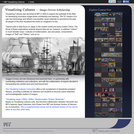
Visualizing Cultures was launched at MIT in 2002 to explore the potential of the Web for developing innovative image-driven scholarship and learning. The VC mission is to use new technology and hitherto inaccessible visual materials to reconstruct the past as people of the time visualized the world (or imagined it to be).
Topical units to date focus on Japan in the modern world and early-modern China. The thrust of these explorations extends beyond Asia per se, however, to address "culture" in much broader ways—cultures of modernization, war and peace, consumerism, images of "Self" and "Others," and so on.

This resource is a video abstract of a research paper created by Research Square on behalf of its authors. It provides a synopsis that's easy to understand, and can be used to introduce the topics it covers to students, researchers, and the general public. The video's transcript is also provided in full, with a portion provided below for preview:
"A new preprint reports one factor that might contribute to the deadliness of the COVID-19 pandemic: wearing shoes indoors. Researchers compared COVID-19 death rates between countries that follow the cultural practice of removing shoes indoors and those that do not and observed a distinct pattern. Those where removing shoes is customary showed a lower death rate on average. Interestingly, no significant differences were observed when countries were compared according to the number of COVID-19 cases. It could be that the lack of reliable, universal testing may obscure the true prevalence of the disease. More work is still needed to discount a number of confounding factors, such as differences in preventive measures enacted by different countries, but the correlation suggests that removing shoes indoors might help curb the devastation wrought by the COVID-19 pandemic..."
The rest of the transcript, along with a link to the research itself, is available on the resource itself.

This resource is a video abstract of a research paper created by Research Square on behalf of its authors. It provides a synopsis that's easy to understand, and can be used to introduce the topics it covers to students, researchers, and the general public. The video's transcript is also provided in full, with a portion provided below for preview:
"Meat is one of the most carbon-heavy foods we eat. Per gram of protein, producing beef, for example, requires 20 times the land and emits 20 times the emissions as growing beans. So steering away from meat is actually a great way to fight climate change, as it vastly shrinks our carbon footprint on the planet. But do households with small carbon footprints necessarily eat less meat than those with large footprints? A new study says no. The researchers behind the study recently examined data pertaining to diet and carbon footprint across 60,000 households in Japan, whose current diet and demographics, scientists believe, could set the trend for the rest of the world. Correlating food-spending patterns with the carbon intensity needed to produce different foods revealed that meat consumption was unrelated to the size of a household’s carbon footprint. Households with small, medium, or large footprints ate nearly identical amounts of meat..."
The rest of the transcript, along with a link to the research itself, is available on the resource itself.
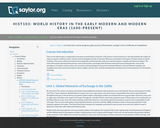
This course will present a comparative overview of world history from the 17th century to the present era. The student will examine the origins of major economic, political, social, cultural, and technological trends of the past 400 years and explore the impact of these trends on world societies. Upon successful completion of this course, students will be able to: Think critically about world history in the early modern and modern eras; Assess how global trade networks shaped the economic development of Asia, Europe, and the Americas in the 17th and 18th centuries; Identify the origins of the Reformation and Counter-Reformation in Europe and assess the social and political consequences of these movements for the peoples of Europe; Identify the origins of the Enlightenment in Europe and assess how Enlightenment ideas led to political and social revolutions in Europe and the Americas; Identify the origins of the Scientific and Industrial Revolutions in Europe and assess how these intellectual and economic movements altered social, political, and economic life across the globe in the 18th and 19th centuries; Compare and contrast how European imperialism affected the states and peoples of Asia, Africa, and the Americas in the 19th century; Identify the origins of World War I and analyze how the war's outcome altered economic and political balances of power throughout the world; Identify the origins of totalitarian political movements across the globe in the 1920s and 1930s and assess how these movements led to World War II; Analyze how World War II reshaped power balances throughout the world and led to the emergence of the United States and the Soviet Union as global superpowers; Assess how decolonization movements in the 1950s and 1960s altered political, economic, and social relationships between the United States, the nations of Europe, and developing countries throughout the world; Assess how the end of the Cold War led to political and economic realignments throughout the world and encouraged the growth of new global markets and systems of trade and information exchange; Analyze and interpret primary source documents from the 17th century through the present, using historical research methods. (History 103)
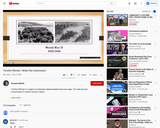
"Comfort Women" is a subject of contentious debate between Korea and Japan. This video focuses on the history of "comfort women" in Korea.
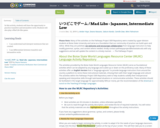
In this activity, students will have the opportunity to practice transitive and intransitive verbs. Students will also play a Mad Lib-like game.
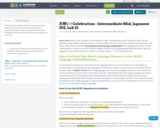
In this activity, students will have the opportunity to plan a party/event for a birthday, anniversary, or graduation. Students will also compare and contrast birthdays, anniversaries, and graduations in Japan and in the U.S.

In this activity, students will have the opportunity to work in pairs to practice grammar on expressing purpose and obligations. Students will learn more about expressing goals and purposes. Students will also learn more about grammar.

In this activity, students will have the opportunity to compare and contrast U.S. and Japanese culture. Students will also explain what is typical at their university. Students will learn about daily life for Japanese students and will learn to express their own culture in the target language.

In this activity, students will have the opportunity to learn about how trash is separated in Japan. Students will also separate trash into different categories.
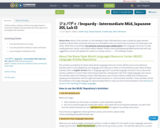
In this activity, students will have the opportunity to review the chapters and materials they have gone over throughout the semester.

In this activity, students will have the opportunity to review the chapters and materials they have gone over throughout the semester.
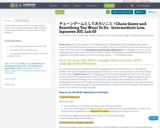
In this activity, students will have the opportunity to practice describing and listing items/topics. Students will also explain what they would like to do in a given situation.
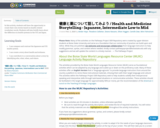
In this activity, students will have the opportunity to create their own stories based on health-related vocabulary words. Students will also briefly learn about the difference in health systems in the U.S. and Japan.
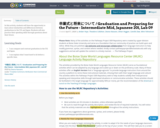
In this activity, students will have the opportunity to learn about similarities and differences between graduations in the U.S. and Japan. Students will also practice their speaking skills through questions about their future.
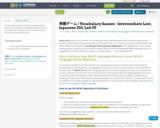
In this activity, students will have the opportunity to learn new vocabulary words and describe what each of the words mean. Students will also answer questions based on the vocabulary words.